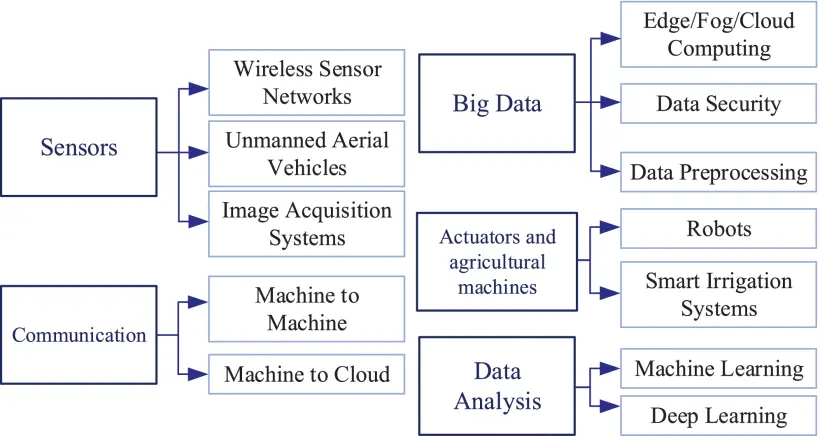Technologies Driving the Shift to Smart Farming: A Review
The global population has resulted in a surge in food demand and production to meet the demand. The pressure to meet the ever-growing food demand and threats to food production, such as pests, diseases, labor shortages, urbanization, lack of professional farmers, and climate change, have spurred a transition from traditional agriculture to smart farming (SF).
SF employs technologies like the Internet of Things (IoT), advanced actuation systems, and data analytics to enhance production. After careful selection, the paper reviews 588 scientific literature to offer practical guidance to SF practitioners. It addresses integration options, key challenges, and proposed solutions to the challenges faced in traditional agriculture practices. Unlike prior reviews catering to researchers, this review article focuses on aiding farmers in adopting technology.
Smart farming (SF) incorporates sensors for data collection in environmental and crop monitoring, using sensor nodes and wireless sensor networks (WSN). Sensor nodes consist of sensors, a battery, a controller, and a transceiver. The Communication aspect in SF utilizes protocols like Machine-to-Gateway (M2G) for sensor-actuator node communication and Machine-to-Cloud Communication (M2C) for data transmission through TCP/IP (transmission control protocol/internet protocol) networks. The choice depends on factors like bandwidth, transmission rate, latency, data volume, and reliability.
Robotics plays a crucial role in SF. It addresses tasks like designing field robots and enhancing existing irrigation machines. This overview emphasizes sensor and communication technologies while delving into challenges and solutions, contributing to a comprehensive understanding of SF implementations.
Smart farming faces significant challenges in handling big data, which are addressed through central cloud solutions like ThingSpeak, Ubidots, and AWS. Edge computing minimizes transfer costs, while blockchain ensures data privacy, fortified by Darkweb tech. Access controls, Kalman filter, and advanced Machine Learning (ML) techniques enhance data security and quality. ML techniques employ regression and classification algorithms and are crucial for insights into sensor-generated data. Deep Learning (DL) with neural networks excels in tasks like environmental forecasting and disease detection, with challenges mitigated by transfer learning.
Smart farming incorporates Remote Monitoring Systems (RMSs) for data collection and visualization, allowing farmers real-time observation and farm-state awareness. RMS architecture varies, from local systems using GSM or Bluetooth for internal applications to IoT-based setups connecting sensors to TCP/IP networks via gateways like Raspberry Pi.
Autonomous systems enhance efficiency and water savings, which is notable in irrigation. The control logic, employing time-based, farmer-based, limit-based, and model-based algorithms, synchronizes actuators in autonomous systems.
Hardware arrangements involve microcontrollers, relays, transistors, and motor drivers. Intelligent Decision-Making Systems, prevalent in disease detection, utilize ML techniques like CNNs. It overcomes challenges through transfer learning and data sources from installed sensors, weather stations, online databases, and agricultural reference material.
No universal solution exists in smart farming. It requires practitioners to tailor choices based on specific needs and constraints. Decisions involve trade-offs, such as cost, power consumption, and design complexity for sensors, and power, coverage, and data rate for communication. More research is needed, including techno-economic analyses, scalability discussions, and robustness evaluations, which can necessitate a shift towards practical industrial models.




